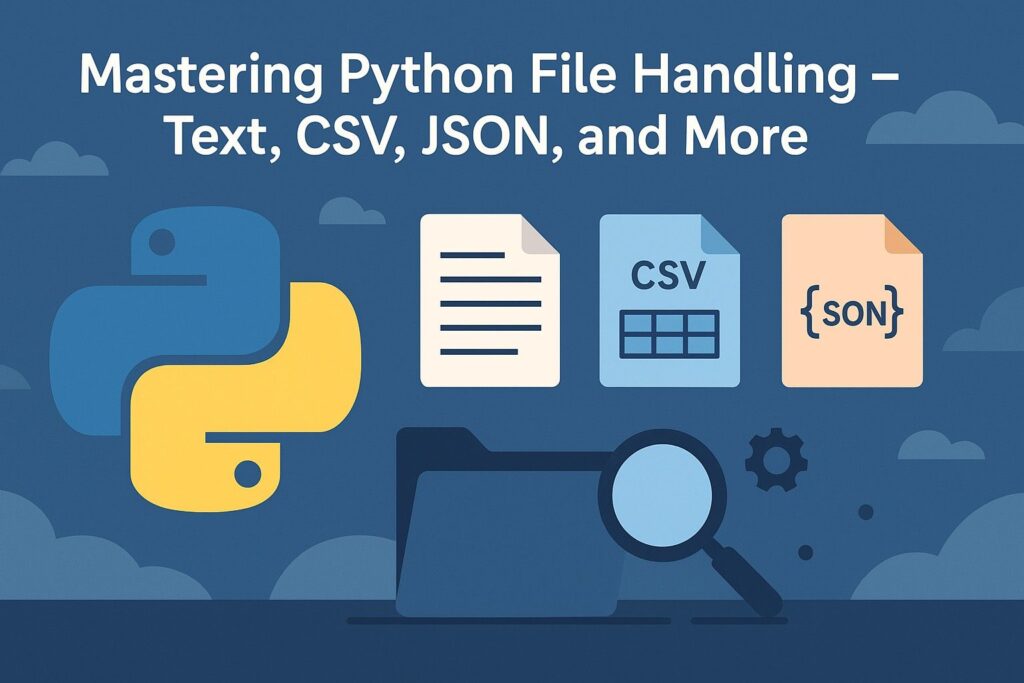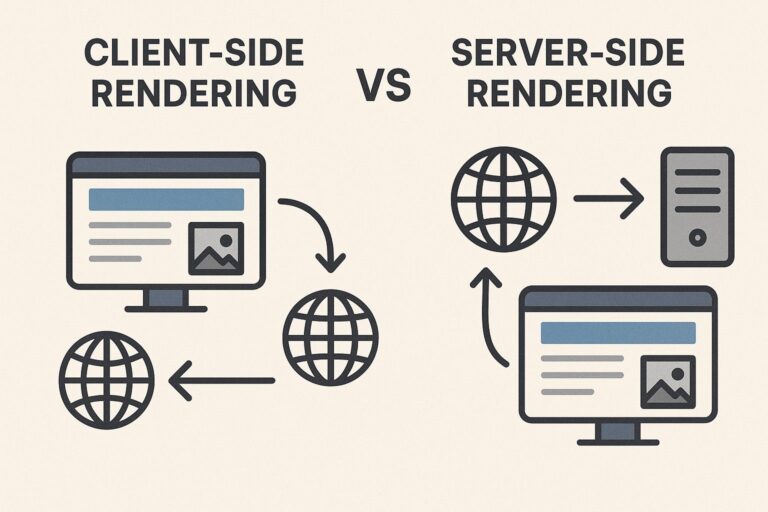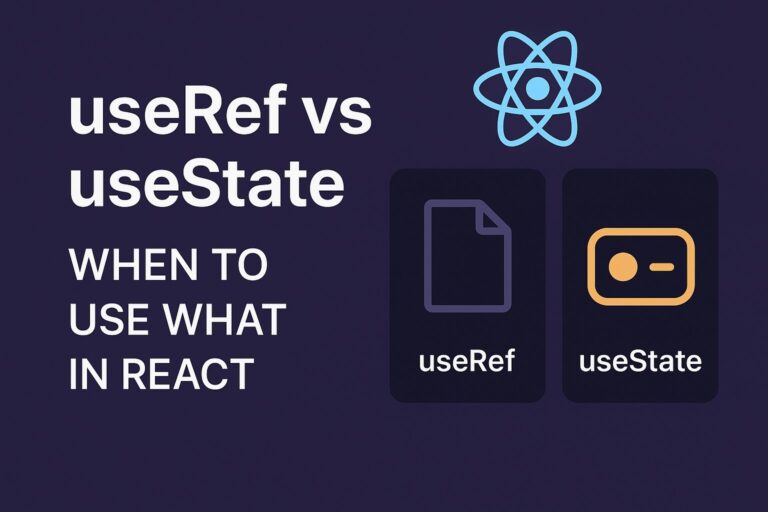
Python offers a rich set of file handling capabilities, making it one of the most versatile languages for working with files of various formats. Whether you’re dealing with basic text files, structured CSV data, JSON configuration files, or binary files like images, Python provides powerful tools through both the standard library and third-party modules.
This in-depth guide explores how to efficiently handle different file formats in Python, avoid common pitfalls, and implement best practices that ensure your code is reliable, maintainable, and scalable.
Why File Handling is Critical in Development
File handling plays a central role in various domains of software development:
- Storing and retrieving user or system data
- Reading configuration settings or environment variables
- Logging system or application events
- Exporting reports or data for other systems
- Ingesting external data into your application
- Processing large datasets from files without using databases
Python’s built-in libraries allow you to achieve all of this without installing any external dependencies.
1. Handling Plain Text Files
Plain text files are commonly used for logs, configuration notes, and human-readable data.
Reading an Entire Text File
with open('example.txt', 'r', encoding='utf-8') as file:
content = file.read()
print(content)
Reading a File Line-by-Line
with open('example.txt', 'r', encoding='utf-8') as file:
for line in file:
print(line.strip())
Reading with readline() and readlines()
with open('example.txt', 'r', encoding='utf-8') as file:
line1 = file.readline()
lines = file.readlines()
Writing to a File (Overwrites Content)
with open('output.txt', 'w', encoding='utf-8') as file:
file.write("This will overwrite existing content.\n")
Appending to an Existing File
with open('output.txt', 'a', encoding='utf-8') as file:
file.write("This will append to the file.\n")
Reading and Writing (r+ Mode)
with open('sample.txt', 'r+', encoding='utf-8') as file:
data = file.read()
file.write("\nNew content added at the end.")
Key Considerations:
- Always specify encoding (
utf-8is safest for cross-platform). - Use
withto ensure the file is closed automatically. - Use
os.path.exists()to check file existence before overwriting.
2. Working with CSV Files
CSV files are a common format for data exchange and analytics tasks.
Reading CSV with csv.reader
import csv
with open('data.csv', mode='r', newline='', encoding='utf-8') as file:
reader = csv.reader(file)
for row in reader:
print(row)
Writing CSV with csv.writer
data = [
['ID', 'Name', 'Age'],
['1', 'Alice', '30'],
['2', 'Bob', '25']
]
with open('output.csv', mode='w', newline='', encoding='utf-8') as file:
writer = csv.writer(file)
writer.writerows(data)
Reading CSV as Dictionaries
with open('data.csv', mode='r', encoding='utf-8') as file:
reader = csv.DictReader(file)
for row in reader:
print(row['Name'], row['Age'])
Writing CSV Using DictWriter
data = [
{'Name': 'Alice', 'Age': 30, 'City': 'Paris'},
{'Name': 'Bob', 'Age': 25, 'City': 'Berlin'}
]
with open('people.csv', mode='w', newline='', encoding='utf-8') as file:
fieldnames = ['Name', 'Age', 'City']
writer = csv.DictWriter(file, fieldnames=fieldnames)
writer.writeheader()
writer.writerows(data)
Additional Tips:
- Use
delimiter,quotechar, andescapecharif working with non-standard formats. - Handle
csv.Errorexceptions for malformed files. - For large datasets, process rows in chunks or use a generator pattern.
3. Handling JSON Files
JSON is widely used for APIs, configuration, and data interchange due to its hierarchical and lightweight structure.
Reading JSON from a File
import json
with open('data.json', 'r', encoding='utf-8') as file:
data = json.load(file)
print(data)
Writing JSON to a File
person = {
"name": "Alice",
"age": 30,
"languages": ["Python", "JavaScript"]
}
with open('person.json', 'w', encoding='utf-8') as file:
json.dump(person, file, indent=4)
Converting Between JSON and Strings
# JSON string to Python object
json_str = '{"name": "Bob", "age": 25}'
data = json.loads(json_str)
# Python object to JSON string
json_output = json.dumps(data, indent=2)
Tips for JSON Handling:
- Use
sort_keys=Truefor consistent key ordering. - Validate JSON structure with try/except around
json.loads. - Handle datetime objects using
default=stror custom serialization.
4. Handling Binary Files
Binary files include media, executables, and any non-textual data.
Reading Binary Files
with open('image.jpg', 'rb') as file:
binary_data = file.read()
Writing Binary Files
with open('copy.jpg', 'wb') as file:
file.write(binary_data)
Use Case Examples:
- Reading PDF, DOCX, or image files.
- Working with pickled Python objects (
pickle.load/pickle.dump). - Sending binary streams in web APIs or sockets.
5. Using os and pathlib for File Management
Checking File Existence
import os
print(os.path.exists('file.txt'))
from pathlib import Path
print(Path('file.txt').exists())
Creating Directories
os.makedirs('logs/archive', exist_ok=True)
# Using pathlib
Path('logs/archive').mkdir(parents=True, exist_ok=True)
Listing Files in a Directory
files = os.listdir('logs')
for name in files:
print(name)
# With pathlib
for file in Path('logs').iterdir():
print(file.name)
Joining and Resolving Paths
from pathlib import Path
base = Path('logs')
file_path = base / 'latest.txt'
print(file_path.resolve())
6. Best Practices for Python File Handling
- Use context managers (
with) to ensure files are closed properly. - Use
try...exceptblocks to handle missing files or permission errors. - Normalize paths with
os.pathorpathlibfor cross-platform compatibility. - Avoid reading entire large files into memory; use buffered or chunked reading.
- Sanitize user-supplied filenames to avoid path traversal attacks.
- Use
tempfilemodule for handling temporary files securely. - Lock files during write operations in multi-threaded or multi-process environments using
filelockor similar libraries.
7. Common Pitfalls and How to Avoid Them
| Mistake | How to Avoid It |
|---|---|
| Not closing files | Always use with open() |
| Wrong file mode (e.g., using ‘r’ instead of ‘w’) | Double-check the mode depending on your intention |
| Encoding errors with non-ASCII characters | Always specify encoding='utf-8' |
| Overwriting existing files unintentionally | Use os.path.exists() or versioned filenames |
| Memory issues with large files | Use generators, readline(), or fileinput for memory-efficient reading |
| Incorrect file permissions on UNIX systems | Set correct modes using os.chmod() if needed |
Final Thoughts
Mastering file handling in Python equips developers with the tools necessary to manage data workflows, automate repetitive tasks, interact with third-party systems, and build robust backend processes. Whether you’re reading user logs, storing analytics, importing configuration files, or exporting processed results, proper file handling ensures reliability and data integrity.
By understanding the intricacies of text, CSV, JSON, and binary file operations—and applying best practices—you can significantly elevate the quality and maintainability of your Python applications.

I’m Shreyash Mhashilkar, an IT professional who loves building user-friendly, scalable digital solutions. Outside of coding, I enjoy researching new places, learning about different cultures, and exploring how technology shapes the way we live and travel. I share my experiences and discoveries to help others explore new places, cultures, and ideas with curiosity and enthusiasm.






